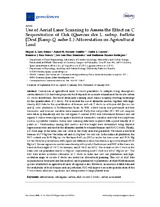Mostrar el registro sencillo del ítem
Use of Aerial Laser Scanning to Assess the Effect on C Sequestration of Oak (Quercus ilex L. subsp. ballota [Desf.]Samp-Q. suber L.) Afforestation on Agricultural Land
| dc.contributor.author | Lara-Gómez, Miguel | |
| dc.contributor.author | Navarro Cerrillo, Rafael M. | |
| dc.contributor.author | Ceacero, Carlos J. | |
| dc.contributor.author | Ruiz‐Goméz, Francisco J. | |
| dc.contributor.author | Díaz-Hernández, José L. | |
| dc.contributor.author | Palacios Rodriguez, Guillermo | |
| dc.date.accessioned | 2020-01-24T07:45:41Z | |
| dc.date.available | 2020-01-24T07:45:41Z | |
| dc.date.issued | 2020 | |
| dc.identifier.uri | http://hdl.handle.net/10396/19371 | |
| dc.description.abstract | Conversion of agricultural lands to forest plantations to mitigate rising atmospheric carbon dioxide (CO2) has been proposed, but it depends on accurate estimation of the on-site carbon (C) stocks distribution. The use of aerial laser scanning (ALS) data is a rapidly evolving technology for the quantification of C stocks. We evaluated the use of allometric models together with high-density ALS data for the quantification of biomass and soil C stocks in a 14-year-old Quercus ilex and Q. suber plantation in Southwestern Spain. In 2010, a field survey was performed and tree dasometric and biomass variables were measured. Forty-five soil profiles (N = 180 soil samples) were taken systematically and the soil organic C content (SOC) was determined. Biomass and soil organic C values were regressed against individual dasometric variables and total tree height was used as a predictor variable. Aerial laser scanning data were acquired with a point density of 12 points m−2. Relationships among ALS metrics and tree height were determined using stepwise regression models and used in the allometric models to estimate biomass and SOC C stocks. Finally, a C stock map of the holm-cork oak cover in the study area was generated. We found a tree total biomass of 27.9 kg tree−1 for holm oak and 41.1 kg tree−1 for cork oak. In the holm oak plantation, the SOC content was 36.90 Mg ha−1 for the layer 0–40 cm (SOC40) under the tree crown and 29.26 Mg ha−1 for the inter-planted area, with significant differences from the reference agricultural land (33.35 Mg ha−1). Linear regression models were developed to predict the biomass and SOC at the tree scale, based on tree height (R2 >0.72 for biomass, and R2 >0.62 for SOC). The overall on-site C stock in the holm-cork oak plantation was 35.11 Mg ha−1, representing a net C stock rise of 0.47 Mg ha−1 yr−1. The ALS data allows a reliable estimation of C stocks in holm and cork oak plantations and high-resolution maps of on-site C stocks are useful for silvicultural planning. The cost of ALS data acquisition has decreased and this method can be generalised to plantations of other Mediterranean species established on agricultural lands at regional scales. However, an increase of filed data and the availability of local biomass and, in particular, SOC will improve accurate quantification of the C stocks from allometric equations, and extrapolation to large planted areas. | es_ES |
| dc.format.mimetype | application/pdf | es_ES |
| dc.language.iso | eng | es_ES |
| dc.publisher | MDPI | es_ES |
| dc.rights | https://creativecommons.org/licenses/by/4.0/ | es_ES |
| dc.source | Geosciences 10(2), 41 (2020) | es_ES |
| dc.subject | Afforestation | es_ES |
| dc.subject | Soil organic carbon | es_ES |
| dc.subject | ALS | es_ES |
| dc.subject | On‐site C stocks | es_ES |
| dc.subject | Carbon assessment | es_ES |
| dc.title | Use of Aerial Laser Scanning to Assess the Effect on C Sequestration of Oak (Quercus ilex L. subsp. ballota [Desf.]Samp-Q. suber L.) Afforestation on Agricultural Land | es_ES |
| dc.type | info:eu-repo/semantics/article | es_ES |
| dc.relation.publisherversion | http://dx.doi.org/10.3390/geosciences10020041 | es_ES |
| dc.relation.projectID | Gobierno de España. CGL2017‐86161‐R | es_ES |
| dc.rights.accessRights | info:eu-repo/semantics/openAccess | es_ES |

